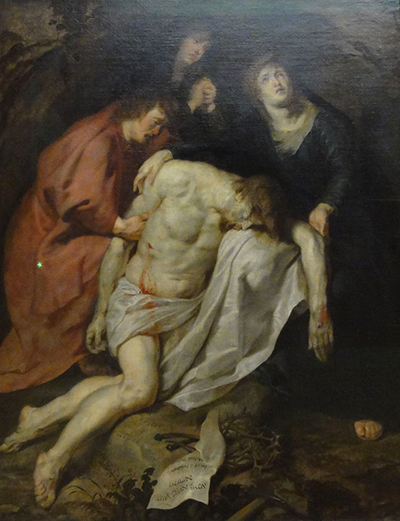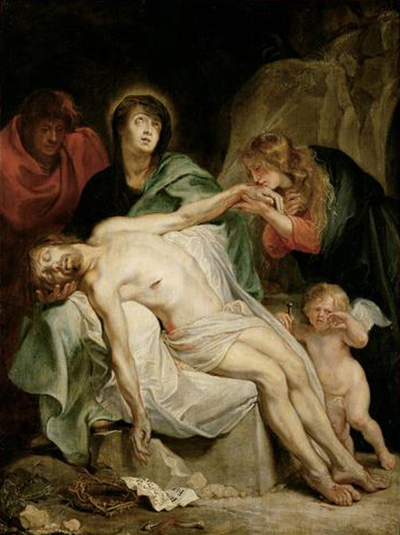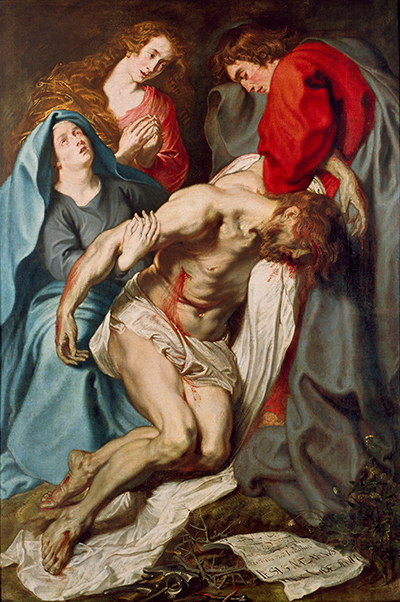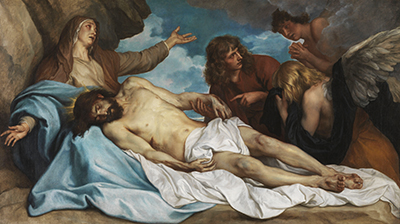 Buy Art Prints Now
Buy Art Prints Nowfrom Amazon
* As an Amazon Associate, and partner with Google Adsense and Ezoic, I earn from qualifying purchases.
Anthony van Dyck was commissioned on multiple occasions to produce depictions of The Deposition, and was able to re-invent the composition each time.
The most famous interpretations of this famous biblical theme were completed in 1615, 1618, 1619 and later in 1635. As news of his success grew, so did word of specific paintings and soon enough others would request similar work for their own premises. Van Dyck was happy to oblige, though he made a conscious effort to bring a uniqueness to each piece and avoid reproducing past work for new commissions.
Role of The Deposition in Art History
The Deposition is also sometimes known as Descent from the Cross and pictures the moment at which Christ is taken down from the cross. The moment shortly after at which his followers see his body and feel grief and sadness at his demise is often known as the Mourning of Christ, or Lamentation. These are important moments within Christian teaching, where the sacrifices of Christ are understood and appreciated.
The significance of these moments meant religious institutions would seek to display them within their own buildings, in the hope of strengthening the word of the Bible. Consequently, famous artists would be commissioned to cover these topics, and Van Dyck became highly regarded for his ability to bring emotion to the theme of The Deposition. Many other artists have also taken on this subject, including Rembrandt, Raphael, Pontormo and Rogier van der Weyden, for name just a few.
It is important to remember that the Bible does not specifically mention the Deposition, though it is implied. Therefore, artists have had to invent the visuals themselves, sometimes drawing on how historical artists have tackled the topic themselves, and adapting these methods to their own artistic style. We therefore see ideas being passed on through generations, creating forms of iconography which became accepted, despite having no connection to any specific Bible passage.
Van Dyck's Series of Paintings
Anthony van Dyck's treatment of this topic was not a standard series, but rather a continued return to the theme, due to the requirements of his donors over the period of several decades. The 1610s brought a number of these works to completeness, in the space of just a few years, before an extended break until the 1630s. Four versions are listed here, and one can immediately see the variety in how he composed these paintings, and whilst Christ was always placed centrally, his posture and angle changed each time.
1615 Version
This earlier piece is now in the permanent collection of the Alte Pinakothek in Munich and was re-purposed for the 1619 version which is very similar in layout. We find Christ with his head leaning to his left, with his body partly held up by his followers. His arms hang down limply, with his head drooping down. The light on Christ's body is not quite as bright as in later versions, suggesting that he decided later to increase the drama and contrast between the different figures in each piece.
 Deposition (1615)
Deposition (1615)
1618 Version
The 1618 version, now to be found at the Kunsthistorisches Museum in Vienna, utilises the most contrasting of light of any of Van Dyck's different paintings. Christ leans to the opposing direction in this one, and is brightened by the artist. Behind him, darkness falls across the sad faces of his followers, other than enough just to see their expressions. Our eyes are therefore drawn directly to Christ himself, who naturally takes the lead role in this composition.
 Deposition (1618)
Deposition (1618)
1619 Version
Here we see a similar layout to that used in 1615. This 1619 version can be found in the permanent collection of the Ashmolean Museum, in Oxford, where it has resided for well over a century. The colours, particularly in the clothing of his followers, is much more vibrant in this version and he also uses a greater contrast of light, bringing drama to the scene. By now, after several previous versions, perhaps Van Dyck was trying to keep himself interested in the subject matter, by increasing the impact of this version.
 Deposition (1619)
Deposition (1619)
1635 Version
The Royal Museum of Fine Arts Antwerp hold the version from 1635, and this composition features the body of Christ lying on a large cloth, whilst being comforted by his followers. To see him lying on the floor in this manner makes him appear even more vulnerable, and desperate, increasing the emotion for viewers looking up at this work. This piece is around two metres wide, allowing the artist plenty of room to work in detail and capture the emotions of the moment.
 Deposition (1635)
Deposition (1635)
Conclusion
We can learn much from the creative process of Van Dyck by comparing his different interpretations of The Deposition. He was a true master, a technical genius, and many would rever his work for centuries to come. The different paintings are now spread around major collections across Europe, and this artist continues to be a major draw for fans of this artistic period, as well as some of the later artists who were inspired by his work.



